by Tom Gaylord, a.k.a. B.B. Pelletier
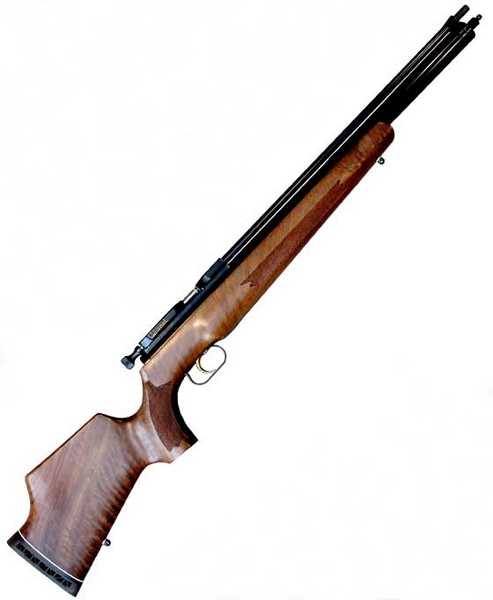
Air Arms Shamal is an attractive PCP. It was Air Arms’ first precharged rifle.
Message from Pyramyd Air
Before I begin, here’s an email message that went out from Pyramyd AIR to everyone who bought a Crosman NP2 rifle from their first shipment.
Subject:
Important Information Regarding Your Benjamin Trail NP2 Purchase
Message:
Thank you for your recent purchase of the Benjamin Trail Nitro Piston 2 airgun from Pyramyd Air (Part # PY-3368-6474). We have been notified by Crosman, the manufacturer of the Benjamin Trail NP2, that there were manufacturing process variances that may have affected some of the airguns in the initial shipment. We have determined that your order came from this shipment. While the variances appear to have impacted only a small number of guns and there are no safety issues, we would like to offer you the following options:
▪ Replace your purchase with a new airgun at no charge to you
▪ Return your purchase for a full refund
Please contact our customer service department at 1-888-262-4867 by July 31, 2014, if you would like to move forward with either of these options. You can also arrange for a replacement directly through Crosman by calling 1-800-724-7486.
Our number one priority is the satisfaction and safety of our customers. We thank you for your continued loyalty and support.
Now, on to today’s report. This report covers:
• Things done differently
• Whassup?
• Ta-da!
• Summary
• Has this blog changed how you think about airguns?
Today’s report may not be very long, but it does represent an interesting bit of serendipity! This is a re-test of my Air Arms Shamal at 50 yards. Of course, that was shot outdoors at my rifle range.
Things done differently
The day was calm — perfect for shooting pellets with accuracy at 50 yards outdoors. You’ll remember that in my last test I went straight to the 50-yard range because I thought this rifle is so accurate that a lesser distance would be a wasted effort. Well, man plans and God laughs! My best 50-yard 10-shot group with 14.3-grain Crosman Premier domes, which I was sure were the most accurate pellets, measured 1.254 inches between centers. You can see that in Part 3.
While 1.254 inches for 10 shots is not that bad for 50 yards with an airgun, it’s certainly larger than I expected from this particular rifle. When I owned it before, I never shot it as far as 50 yards, but at 35 yards it was a killer. I just assumed it would hold together for the extra 15 yards; and when it didn’t in the last test, I was embarrassed.
Someone suggested that I clean the bore with a bore brush and J-B Non-Embedding Bore Cleaning Compound, so I did. I had to clean from the muzzle because the breech is not accessible with the bolt in the way. Because I couldn’t keep J-B Paste out of the transfer port, I didn’t use very much on the brush. Otherwise, the cleaning job was the same as always.
Then, I took it out to the range a second time 2 weeks ago, filled it with air and prepared to shoot. The Shamal is a single-shot, so getting it ready isn’t a big chore — or so I thought!
Then, I boarded the boat to Serendip. My first group on this dead-calm day put 10 Crosman Premiers into 0.818 inches! Yeah, that’s right! I shot a 10-shot group that can almost be covered by an American Quarter! Almost!
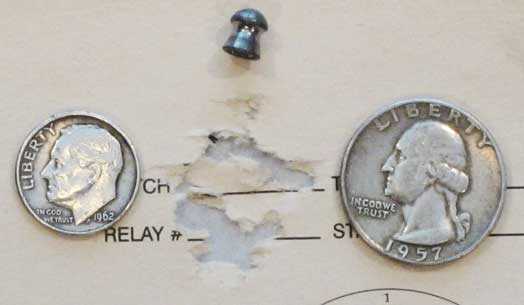
The first group of 10 Crosman Premiers went into 0.818 inches at 50 yards. It can almost be covered by an American quarter. That’s phenomenal!
Whassup?
Okay, what gives? This is the same pellet, same gun, same quiet weather, same distance, same shooter. Did I suddenly have an attack of virile youth? Did I suddenly remember how to shoot again? How can my groups shrink by almost a half inch (0.436 inches), when the only thing that changed was the calendar?
And why was the Shamal suddenly accurate — like I remembered? I wouldn’t mind being an old goat who can’t shoot anymore, but this off-and-on thing drives me nuts. It makes it hard to believe anything I write — even for me.
Well, the proof of the pudding, as they say, is in the eating. So, I decided to chance a second group on the same fill. You know — just to see what would happen. In case you haven’t been following this report closely, I discovered in Part 2 that this Shamal has a maximum fill pressure of 2250 psi and gets 16 shots before needing to be refilled. I’d already shot 10 on the current fill, so I’m wandering off the power curve to shoot another 10 — or at least that’s what I thought!
The next group stretched out taller than it was wide, with a max spread of 1.126 inches between centers. That’s considerably larger than the previous group, yet still somewhat smaller than the best group from the previous test. Well, I’m now off the power curve for sure, so it’s time to fill the reservoir.
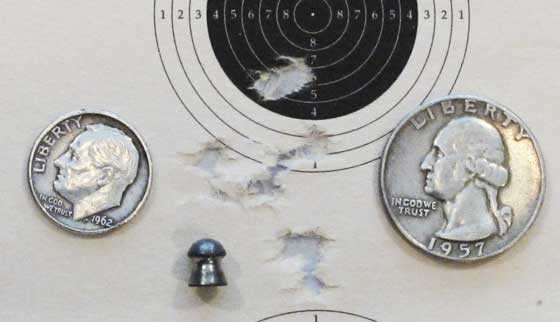
The second group on the same fill was strung vertically but was also smaller than the entire previous range test — at 1.126 inches between centers. Same Premier pellet.
Ta-da!
I connected the rifle to the carbon fiber tank and began the fill. When you start filling a PCP, you can always tell how much pressure is left in the gun, because the needle on the gauge will stop moving fast and start moving slower as the rifle’s reservoir opens to accept air. The point at which that occurs is the pressure that was already in the gun’s reservoir. This Shamal has a second quirk. It makes a loud buzzing noise when the reservoir is taking a fill. So, if you missed where the needle stopped, there will always be the noise to tell you when the rifle starts accepting a charge.
This time, the needle slowed down when it hit 2800 psi on the gauge, and that’s when the buzzing began! The rifle I was shooting had been overfilled to 3000 psi.
I was so shocked by this that I almost didn’t stop the fill. But I did and the rifle now had about 2900 psi in it. Going back to what was learned in part 2, the rifle was now grossly overfilled.
But curiosity demands to be satisfied, so I disconnected from the tank and returned to the shooting bench. The next 10 Crosman Premier pellets went into an identical 1.126-inch group! Oh, there’s no doubt some small size difference between them, but none large enough to see. Curiouser and curiouser!
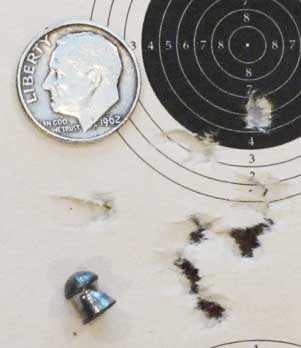
After refilling the rifle to 2900 psi, I shot this 1.126-inch group with Crosman Premiers.
Knowing beyond the shadow of a doubt that there was more than enough air remaining in the reservoir, I shot another group. These 10 went into 1.268 inches. That’s slightly larger than the smallest group I was able to shoot the last time (1.254 inches). That’s 2 more okay groups from the rifle, and a total of 4 for this day.
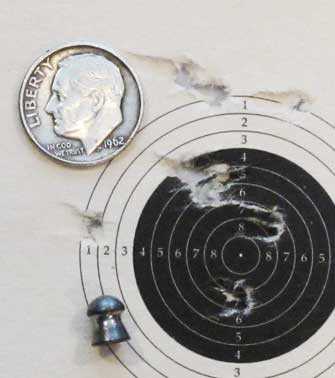
The final group was a little larger — but not much. Ten Premiers went into 1.268 inches at 50 yards.
But I know this rifle. It takes at least 40 shots to drop the pressure from 3000 psi down to 2250 where the power curve begins. I’d just fired 20 shots toward that end, but I’d also taken up more time out of a day in which I had another airgun to test — namely the Hatsan AT44-10 Long QE (read that report later this week). So, I stopped shooting the Shamal at this point.
Summary
I don’t know what’s going on, except that when this rifle is overfilled to the point that the pellets are leaving the gun at 650-690 f.p.s., it’s more accurate than when the gun is shooting the same pellet at about 790 f.p.s. Or at least that’s what it looks like. I think I need to get back to the range and do some more testing — a lot more testing!
Has this blog changed how you think about airguns?
I initially published this section on the May 30, 2014, blog, and I’m going to repeat it at least once a week through the end of July so it doesn’t get lost or forgotten.
From the comments many of you make, it sounds like the blog may have positively impacted your shooting and/or airgunning in general. I invite you to send me an email telling me about that impact.
Were you a firearms shooter who accidentally discovered airguns through this blog? If so, tell me how this blog has helped your understanding of airguns.
Were you already an airgunner, but you thought what you saw in the big box stores was all there was? If so, how has this blog helped you understand more about airguns?
I’ve gotten quite a few responses already, but I want to make sure you know that I’m not looking for “attaboys,” pats on the back or personal recognition. I’m looking for real feedback on how the information in this blog and the comments from your fellow blog readers have enriched your airgunning experience, what you’d like to know and what you’re still unsure of. This blog is written for its readers, and I want to share your stories with others who may be where you were before you found this blog.
Pyramyd AIR has created a special temporary email address so you can send me your feedback. I’ll be the only person to get these emails, and we’re not going to generate any lists from the addresses.
My plan is to publish one or more blog reports with the more interesting comments. If you give me written permission, I’ll use your real name or blog handle, otherwise your comments will be anonymous.
This email address will be live for only a few weeks. We have tens of thousands of readers worldwide. Even if you’ve never commented on the blog, email me your message. If you’re reading this blog after July 2014, email submissions will no longer be forwarded to me, and you may get an auto-reply email stating that or your email might bounce back to you.

Sounds like you hit the Jackpot to me! Good job B.B.! mistakes are educational too. Onward & upward!
Reb
Now if you would just give it up and send that Shamal to me I could get this all worked out for you. I would not have all these other airguns getting in the way of my doing a shot by shot diagnosis. I could spend several days or weeks researching the idiosyncrasies of this rifle and determine once and for all whether it was the rifle or the shooter. 😉
And my offer is still open, BB! Send me that Shamal for disposal before it frustrates you even more….
Yeah, it’s too bad that you’re so busy you don’t have time to stay with it and work things out. How frustrating. So if I understand everything correctly for this PCP: overfilled, causes less valve opening, causing less air release and therefore slower velocity on first group. First group was tighter with lower velocities than subsequent groups at higher velocities. It does all make sense unless you’re sure you shot tighter groups last time with the same pellet and higher velocities. Could a difference in pressure gage calibrations have caused a chance in your shooting conditions?
Perhaps a different or heavier pellet would do better. How about a few cleaning pellets to help wipe the bore cleaning compound residue out of the transfer port and breech oring area?
Feinwerk,
I wouldn’t use cleaning pellets in a PCP. That air blast could distribute them to places I don’t want.
B.B.
Oh… are you saying this is bad practice? Could you elaborate? I usually load 3 cleaning pellets, followed by a lead pellet in both springers and pcps. The pellets come out relatively straight but the felt pellets curve and slow quickly. If I aim down toward grass 10yds away I can usually track and recover at least one of the three cleaning pellets to see how much dirt they picked up. If I shoot into a 5 gal bucket of water, I can recover all of them for inspection.
Feinwerk,
If it works for you keep on doing it. It’s just something i wouldn’t do.
B.B.
I have come to appreciate and accept your expertise in all matters airgunning, BB,,, and here comes the but,,, BUT,, would it be possible for you to expand on your reasoning for abstaining from the use of cleaning pellets. I have read, previously, other remarks , by you, deriding the practice,, and I was wondering if there were technical reasons,, or simply a personal one you would rather not talk about.
I mean no disrespect, I simply want to know about items and methods that might do damage to my guns.
Ed
Ed, I’m not B.B. but here’s some info.
These cleaning pellets, as well as cotton swabs can leave little pieces of themselves in transfer ports and any baffling that may be part of the gun. Gotta keep an eye out for that stuff!
Reb
Ed,
I’ll do even better than that. I will write an entire report on the subject. It’s going into the book!
B.B.
In addition to potentially causing damage to your airgun, whether it’s a pcp, msp, ssp or springer, I’ll never be convinced that cleaning pellets effectively clean an airgun barrel.
The best thing I can say about felt cleaning pellets is that they were a cunning marketing ploy by Beeman. Brilliant.
kevin
Feinwerk,
while using cotton swabs to clean my 760’s barrel I accidentally found that they usually make it the 10m to the pellet trap,although no bullseyes they were easy to recover.
Reb
I don’t own a PCP, but I’m still interested in your comment. What do you mean when you advise not to use a cleaning pellet in a PCP? Just not following you.
Rob
Never mind. When I refreshed the page I found the yours and others comments.
If you’re shooting 1.3″, 10 shot groups with an airgun at 50 yards consistently shaving off a 1/2″ from your group sizes is a challenge.
Inconsistencies in pellets that are shot straight out of the tin/box can account for fliers/larger groups (no I’m not suggesting a part 6 where pellets are rolled, weighed and sorted).
In my experience it’s usually parallax in the scope and/or inconsistent cheek weld that opens up groups.
Interesting that the first group shot out of that freshly cleaned barrel was the best of this session. What was on the last patch that went through the barrel? Ballistol? FP-10? Whatever it was, if anything, I would lightly lube the pellets with it and see if that would give me increased consistency.
I know B.B. doesn’t believe in lubing pellets but it’s something I would try since I can’t help it. I’m off to see my shrink.
kevin
Kevin,
I don’t mind lubing pellets. I didn’t think of that for such a low-velocity air rifle, but you may be onto something.
B.B.
B.B.,
Just curious, do you lube your bullets when reloading?
Reb
Rewb,
Are you asking about bullets for firearms, or for airguns? I do lube firearm bullets, but not airgun bullets (that’s big bore airguns).
B.B.
Yes, my question was regarding firearms.Furthermore you know what the benefits are also. And I wonder how heel bullet wax would affect big bore rounds.
Reb
Reb,
I have tried lubing big bore airgun bullets with SPG, which is a very soft lube. It didn’t hold as tight as an unlubed bullet. But you won’t know until you try.
B.B.
That’s the spirit!
Matt 61, here’s a couple things to check with your M-1. Make sure that the overall length of your hand loads is the same as your ball ammo. As to IMR-4064, my M-1 has shot well with 48.0 to 49.0 grains of IMR-4064 and 150 grain bullets. If bullets are being pushed back into the case they are hitting something prior to chambering. Too short an overall length or the wrong bullet shape could cause this. Of course, I’m only suggesting things I have seen since I can’t see your rifle. I have never needed to crimp my M-1 reloads.
Mike
Hi Mike. Thanks a lot. I actually adjust my die with a round of Greek surplus ammo. The overall length is 3.323 +/- .0005 inches which should be okay according to my handbook. That’s good to hear about your use of IMR 4064. The problem is that my gun was adjusted for a specific load, and now the inventor is offline!? Still, I believe that the correct load must not be that far off of normal. The crimping could well be the problem. My gunsmith said that he didn’t crimp his rounds either. The only reason I’m doing it is because without the crimp, I’ve had too many rounds come apart and spread gunpowder everywhere. Since I can’t disassemble the gun to clean it, that is a real problem. I should add that the deformations to the rounds are not part of the normal recoil of the gun, which I’ve heard is the main reason for crimping. That’s never been a problem. The difficulties come when the cartridge is not lined up properly with the bolt comes forward and the cartridge gets rammed forward onto the edge of the breech with the full power of the bolt. I don’t know any crimping that could stand up to that. Even the military surplus got bent although not as badly as mine. Anyway, in adjusting for the crimp, how many grains of propulsion equals a factory die crimp job? 🙂
I think another problem is that not only is the pressure for this gun higher than the norm, but it may well be more sensitive and less forgiving of deviation. I had not expected this. On other hand, I can’t blame the gunsmith. He advertised rifles for master-class shooters, and I suppose those super-competitive people are willing to do any amount of fiddling to get their M1s to perform to the maximum. And the situation is not without hope. The very sensitivity of the sweet spot may be why I’ve had so much trouble finding it. Its very absence indicates that it is there (he reasons to himself). So when I find the right combination, that rifle will perform flawlessly. 🙂
Matt61
I’m sure there is a gunsmith that can help you with that rifle. An M-1 that you can’t take down will be a source of problems that never end. My service grade DCM (except for the trigger group) M-1 will shoot my handload into 2 to 3 inches at 100 yds if I do my part. How much better does it need to be? We have a surplus military rifle shoot here once a month. It is great fun to shoot and it works.
Good Luck and Enjoy.
Mike
Maybe this gun has two places in the power curve that would work good depending on where the gun is sighted at and filled to.
Bingo!
Also I got a picture I’m going to post in a bit from my phone. So it ain’t going to be #1 quality. But its a picture of a couple of groups that I shot with the HW 50 S yesterday. Hope I can get it posted.
I will have to try to post the picture tonight when I get home. I cant get my phone to work right.
Here is the pictures. And don’t make fun of my target please. Its a phone book with three 2×4’s cut to size and duct taped to the back of the phone book. Then I wrap around the tape over the front and around the back up and down wise then side to side. Then I just draw a blue circle with my ball point pen. Then once you shoot at it you just add some more tape. And draw more circle targets. This phone book has over 500 shots to it and still ready for more. And its fairly quiet when the pellet hits.
But here it goes. hope it works.
http://s1373.photobucket.com/user/gcars/media/0623141236_zps38f6f671.jpg.html
http://s1373.photobucket.com/user/gcars/media/0623141235_zps66d721ca.jpg.html
The one picture with the flyer is when I had my finger resting on the trigger and the gun fired. (yes I adjusted the trigger and its on the light side) And both pictures are 5 shot groups at 50 yards bench resting the gun. This gun is on the money. Very happy I got it.
Do we need to start a Shamal counseling group? When I shot my Shamal at the Dallas FT it did not seem to group the same as it did when I sighted it in. It drove me crazy all day. If I shoot FT this weekend at Pecan Plantation I am going back to the USFT Hunter.
By the way, your gun does have much nicer walnut figure than my rifle.
David Enoch
Extending the offer I made to BB to you as well, David E. Send me your Shamal for proper disposal so it won’t cause you anymore grief… Might as well take care of both of these trouble-makers at once… 😉
/Dave
BB,
In light of what is basically a recall of the NP2, are you going to continue testing the rifle you have or attempt to receive another rifle to test?
John
John,
The situation right mow is I plan to continue testing the NP2 I started testing. Crosman has assembled an NP2 they sent to Pyramyd AIR for me to test, and I plan on testing that one, as well, when it arrives. I expect it this week.
B.B.
Good guns from this first run will inevitably be sought after by deep pockets.
This post is very encouraging to show that unexplainable things do happen. So, why the heck did my M1 work fine with the Greek surplus that used to jam it? I’m bolstered to continue searching. On the hand, I must admit that today’s post with all its subtleties of fill pressure are not exactly an advertisement for pcps.
Matt61
It seems to me you should have kept shooting this gun (on the same calm day conditions) rather than setting it down (still roughly overfilled) and start theorizing! IMHO you should have shot at LEAST 30 more rounds to get the gun down to the low side of the curve.
Tom,
This is probably a stupid question, and maybe you’ve already answered this so bear with me… Was the Shamal design originally intended as a non-FAC air-rifle that was tuned to deliver more power as a FAC and US export version? I’m wondering because maybe something about the design makes it more accurate at around 12 ft-lbs?
J.
J.,
I wonder that, too. Air Arms wasn’t exporting to the U.S. so much when the Shamal was made, so perhaps you are right. But I don’t know how we would prove it.
B.B.
Tom,
I don’t know that we can prove it one way or another, short of asking Air Arms. And its doubtful they would know the answer at this point if the Shamal is a 20-30 year old model. The reason I even thought of this is that it is behaving like the Air Force Escape and maybe some of the other variable power PCPs you’ve tested (there are so many blog entries its sometimes hard to keep them all straight) in that it shoots better at a lower velocity.
Regardless of why it does it, since the Shamal does seem to shoot better at a lower velocity, maybe you should try heavier pellets in it.
J.
J.,
Well, that is a thought.
B.B.